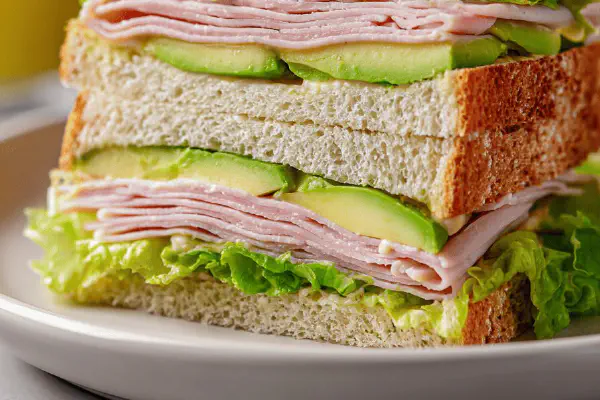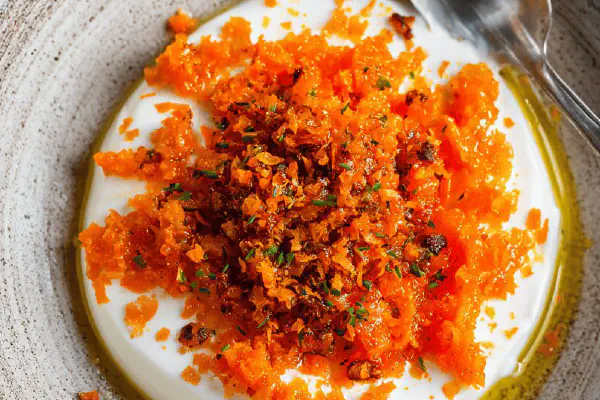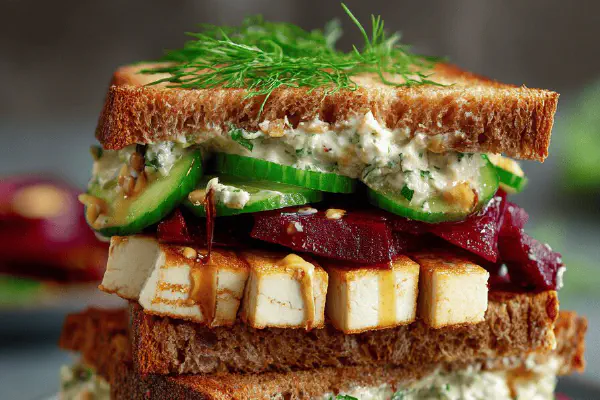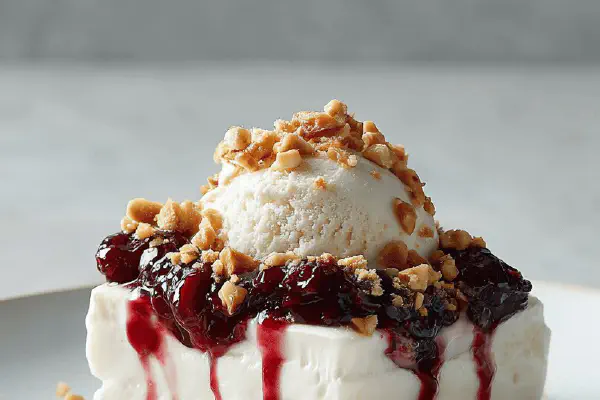Peanut Butter Jam French Toast Sandwiches
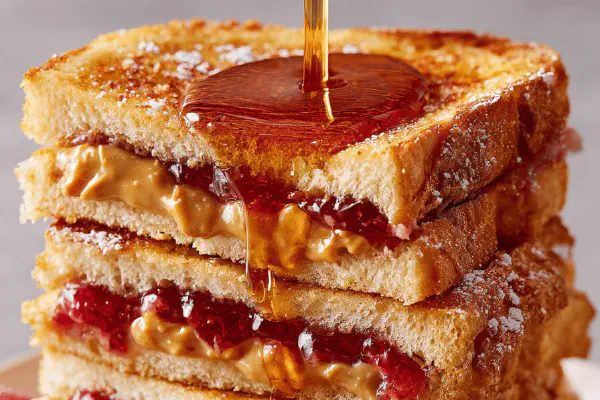
E
By Emma
Certified Culinary Professional
•
Recipe tested & approved
Eggs whisked with milk, sugar, vanilla, cinnamon. White sandwich bread layered with peanut butter and raspberry jam. Soaked, pan-fried in butter till golden crust forms, finished warm. Served with maple syrup. Adjusted sugar and ingredient quantities slightly. Added lemon zest for brightness. Cooking time tweaked for texture. Clear visual and tactile cues to avoid soggy bread or burnt crusts. Efficiency tips and ingredient swaps included for nut allergies and pantry constraints. Emphasis on aroma, texture, sizzling sound as doneness signals. No em dashes used.
Prep:
14 min
Cook:
12 min
Total:
26 min
Servings:
4 servings
#breakfast
#sandwich
#peanut butter
#jam
#French toast
#quick meal
#sweet and savory
Eggs. Milk. Sugar. Cinnamon. Jam and peanut butter slathered between soft white sandwich bread slices. Take that combo, dip in rich egg mix, fry slow till golden-crisp. Heard them sizzle? That crisp snap means caramelization underway. Aromas hit—cinnamon, vanilla, butter melting into crust. But mess up and you’ve soggy bread or charred disasters. Years in the kitchen showed me soaking just right matters more than timing. Watch the bread’s sheen, soft but not floppy. And the flip—gentle, slow, no rush. Served alongside maple syrup pools that clink on contact. Swap raspberry for strawberry jam or almond butter if nuts offend. Add lemon zest? Brightens whole thing. This isn’t a fancy breakfast. It’s breakfast done right—simple, nostalgic, kinda messy. But worth every bite.
Ingredients
- 2 large eggs
- 130 ml 1/2 cup plus 1 teaspoon milk
- 28 ml 1 1/2 tablespoons sugar
- 5 ml 1 teaspoon vanilla extract
- 2.5 ml 1/2 teaspoon ground cinnamon
- 1 tsp lemon zest, finely grated
- 8 slices white sandwich bread
- 60 ml 1/4 cup raspberry jam
- 60 ml 1/4 cup peanut butter
- 30 ml 2 tablespoons unsalted butter
- Maple syrup for serving
About the ingredients
Eggs and milk ratios impact soaking—more milk thinner the egg bath, risk soggy bread. Less sugar keeps sweetness balanced; sugar aids browning so don’t omit it altogether. Vanilla and cinnamon bring warmth—cinnamon can overwhelm if added heavy-handedly. Adding lemon zest is my twist; it cuts richness and adds fresh brightness. For jam, raspberry works beautifully because of tartness; reduce sugar in jam if it’s sweet-heavy. Peanut butter should be creamy but not oily; oily kinds make bread collapse. Almond butter is a solid substitute if avoiding peanuts. Butter for frying—unsalted keeps flavors clean; clarify it for higher heat tolerance. Use a sturdy white sandwich bread—too thin or dry won’t soak right.
Method
- Put eggs in large bowl. Whisk in milk, sugar, vanilla, cinnamon, lemon zest until blended smooth.
- On clean surface, spread raspberry jam evenly on 4 slices bread. Spread peanut butter thickly on remaining 4 slices. Press jam and peanut butter slices together, forming 4 sandwiches.
- Dip one sandwich at a time into egg mixture. Let it soak enough to saturate bread but not soggy—test by lightly pressing edge; it should feel soft but hold. Place dipped sandwiches on a plate.
- Heat large nonstick pan over medium-low heat. Melt half butter—listen for gentle sizzle, bubbles forming around edges. Place 2 sandwiches in pan without overcrowding.
- Cook sandwiches about 2 1/2 minutes per side, turning when golden brown crust forms. Edges firm, color deep golden, smell nutty and sweet, hints of cinnamon. Use spatula gently—avoid collapsing bread.
- Transfer cooked sandwiches to baking sheet in oven set at 93 °C 200 °F to keep warm. Repeat with remaining butter and sandwiches.
- Serve immediately with warm maple syrup drizzled on top or on side.
- If jam too runny, reduce by simmering gently before use to avoid soggy bread.
- If peanut butter sticky or too thick, warm slightly or switch to almond butter—watch for allergy.
- Best eaten fresh; bread textures degrade with time. Toast day-old bread lightly before assembly for sturdier hold.
- Listen for steady sizzle not harsh popping. Too hot? Butter browns immediately, sandwich chars outside, raw inside. Reduce heat then.
- If sandwich falls apart dipping, press bread slices firmly when assembling. Don't over-soak in egg wash.
Cooking tips
Whisk eggs and liquids first for uniform texture; lumps mean uneven soaking later. Assemble sandwiches tight to avoid fillings escaping when flipping. Dip briefly, no dunk—test by pressing edge; bread should feel pliable, not flimsy. Low-medium heat crucial; too high burns exterior, leaves raw inside. Listen close—steady sizzle, no crackling means correct temperature. Flip gently with spatula to keep sandwich intact. Keeping sandwiches warm in a low oven avoids soggy mishaps and lets juices settle. Remove from oven briefly before serving to regain crust crispness. If jam too runny, simmer down separately to thicken; watery preserves ruin texture. Use leftover bread slightly toasted to boost hold under egg. Watch texture over timer—trust your eyes and touch for mastery.
Chef's notes
- 💡 Egg and milk ratio crucial. More milk thins batter – bread soaks too soggy, loses shape. Less sugar means less caramel brown but helps keep balanced sweetness. Vanilla and cinnamon go light. Cinnamon easy to overpower here. Lemon zest brightens without water logging bread. Jam tartness works better than overly sweet.
- 💡 Dip sandwiches briefly. Don’t soak like sponge. Press edge to test softness. Soft but not floppy means ready. Over-soak ruins texture; sandwich falls apart when flipping. Assemble tight. Press slices firm. Keep heat medium-low. Listen for steady sizzle bubbles around butter edges. No crackles means right temp. High heat burns outsides, raw inside still.
- 💡 Butter: unsalted preferred. Clarify if possible for more heat tolerance. Butter browns quickly - reduces risk burns when heat controlled. Use sturdy white sandwich bread. Too thin tears, too dry soaks unevenly. Toast day-old bread slightly first for firmer hold. Jam runny? Simmer to thicken. Avoid watery spreads.
- 💡 Flip sandwiches gently with spatula. Avoid smashing bread. Golden edges crisp, smell nutty and sweet with faint cinnamon signals readiness. Cook about 2.5 minutes each side. Use low heat for caramelizing, no rush. Keep finished sandwiches warm on baking sheet in low oven. Prevents sogginess, holds texture.
- 💡 If peanut butter too sticky or thick, warm slightly to loosen. Almond butter swap if allergic. Jam types can swap too – strawberry good alternative. Watch texture closely during all steps. Listen to butter sizzle and bread’s feel. Aroma buildup means flavors melding. Cool down heat if butter browns too fast or sandwich chars.
Common questions
Why soak bread briefly?
Soak just enough to soften. Too wet breaks sandwich. Press edge, soft but firm. Holds filling without collapse. Timing matters. Quick dip.
What if jam runs too thin?
Reduce jam off heat. Simmer gently. Thick jam avoids soggy bread. If jam watery, spreads and texture fail. Simmer down concentrate flavors too.
How to prevent burnt crust?
Medium-low heat crucial. Listen for steady sizzle not crackle. Butter browns fast when too hot. Lower heat if sandwich chars outside, still raw inside. Patience helps here.
Best way to store leftovers?
Wrap airtight fridge; eat next day. Toast lightly before remaking sandwich to bring back sturdiness. Reheat gentle in oven avoids soggy crusts. Microwave ruins crisp. Use dry heat.
